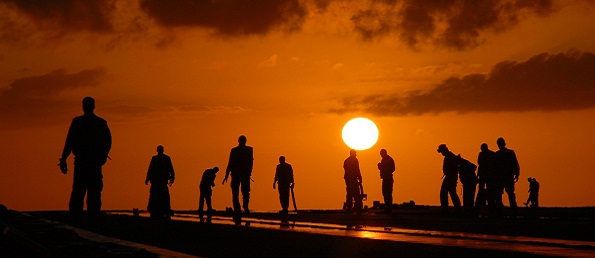The hidden threats that could imperil the sustainable economy

Washington, The world’s economies and people face hidden dangers to sustainability that demand immediate action, according to State of the World 2015: Confronting Hidden Threats to Sustainability, the soon to be released edition of the annual series from the Worldwatch Institute.
These threats, driven directly or indirectly by growing stress on the planet’s resources, have the potential to upend social systems, environmental balance, and even entire economies (www.worldwatch.org).
“These threats are hidden in the sense that they are commonly overlooked or underappreciated. But addressing them is critical to building sustainable societies.” Ed Groark, Acting President of Worldwatch.
The report outlines a set of issues whose roots in resource overconsumption are typically not explored in news accounts. The threats identified are diverse, ranging from emerging diseases that originate in animals and growing dependence on imported food to the problems of energy availability and increasingly degraded oceans.
The common link among these various challenges—humanity’s rising claim on the planet’s resources—suggests the urgent need to commit to sustainable economies in which resources are stewarded and the environment is protected.
Over the last few decades, human societies have come to comprehend that they are depleting resources at unsustainable rates, spreading dangerous pollutants, undermining ecosystems, and threatening to unhinge the planet’s climate balance.
But a reckoning is complicated by the fact that the complete environmental impacts are not always readily discernible—they are camouflaged and multiplied by discontinuities, synergisms, feedback loops, and cascading effects.
And the manner in which environmental impacts translate into the social and economic spheres further complicates the picture, producing unexpected consequences. Even economic growth, long unquestioned and coveted, needs to be examined with healthy skepticism.
“These are significant threats, but each and every one of them has solutions, especially if we commit to an ethic of stewardship, robust citizenship, and a systems approach to addressing the challenges that we face,” says Groark.
For many of these hidden threats, the solutions are common sense.
For example, more rapid adoption of renewable energy systems would reduce the pressure to find ever more exotic sources of fossil fuels. And the pressure to import food could be reduced by effectively increasing food supplies through reductions in food waste—about a third of the global harvest is lost each year.
But this requires that economics ministers and others set human well-being, rather than growth, as the primary economic objective, shifting the global economic machine away from intensive resource use and the endless pursuit of “more.”
We think we understand environmental damage: pollution, water scarcity, a warming world. But these problems are just the tip of the iceberg. In State of the World 2015, eight key hidden threats to sustainability are addressed in depth, along with the central question of how we can mitigate their impacts or develop resilience to these and other shocks. State of the World 2015 brings to light challenges that we can no longer afford to ignore.
What are the Hidden Threats to Sustainability?
Expensive energy and debt
- Cheap energy is the lifeblood of industrial economies, but inexpensive, easy-to-extract fossil fuels are increasingly difficult to find, a development that is quietly driving up debt.
- The ups and downs of market prices for oil camouflage the underlying reality that the cost of large-scale extraction of oil in tough places is rising. Production costs have increased 17 percent annually since 2002, compared with annual inflation of 2 percent for the economy overall.
Economic growth
- Economic growth is a key driver behind the changing climate, the decline in species, and the destabilization of oceans and other major biomes. These global-scale dysfunctions make economic growth a threat that is hidden in plain view.
Growing dependence on food imports
- Import-dependent countries are vulnerable to supply disruptions and high prices if supplier countries experience poor harvests or if they choose to manipulate food supplies for political purposes.
- More than a third of the world’s countries now depend on grain imports for 25 percent or more of domestic consumption, and a quarter import more than half of their grain.
Stranded assets
- Resource scarcity and environmental degradation are impairing the value of investment portfolios.
- By one estimate, a carbon budget limiting temperature increase to 2 degrees Celsius will require that 80 percent of proven fossil fuel reserves remain unburned.
Damage to oceans
- Overfishing dominates the headlines when it comes to oceanic degradation, but ocean acidification, nitrogen runoff, and plastics pollution are serious issues as well—and are still not adequately understood.
- Oceans absorb carbon that cannot be taken up by the atmosphere, but this has made the oceans more acidic. Their capacity to absorb carbon is not unlimited, a threat that has unknown repercussions to human well-being.
Climate migrants and refugees
- Knowledge remains limited about how climate disruptions will affect communities and people around the world—including how many people may face displacement and how well they will manage to adapt.
- Weather-related disasters displaced 140 million people—an average of 23 million people per year—between 2008 and 2013.
Spread of animal diseases to humans
- Population growth and changes in land use have pushed human settlements closer to wild populations of animals, exposing humans to infectious diseases such as AIDS, SARS, and Ebola.
- Some two thirds of human infectious diseases originate in animals, and the jump of infectious agents to humans is facilitated by environmental degradation.
For more information on State of the World, the Institute’s annual flagship publication, view the complete book series.



